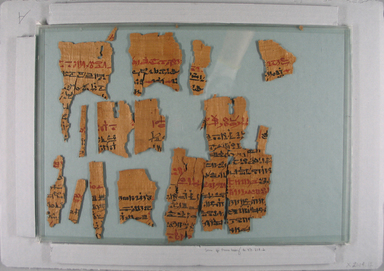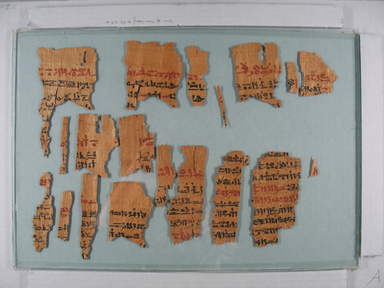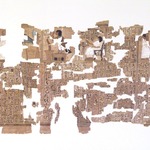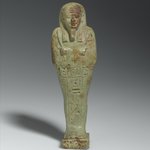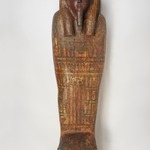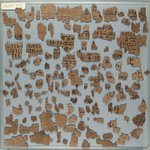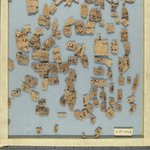Medical Text Inscribed in Hieratic
Egyptian, Classical, Ancient Near Eastern Art
MEDIUM
Papyrus, ink
DATES
664–525 B.C.E.
DYNASTY
Dynasty 26, or later
PERIOD
Late Period, probably Saite Period
DIMENSIONS
e: Glass: 14 3/16 × 24 5/8 in. (36 × 62.5 cm)
e: Largest Fragment: 9 3/4 × 21 9/16 in. (24.7 × 54.7 cm)
(show scale)
ACCESSION NUMBER
47.218.2a-g
CREDIT LINE
Bequest of Theodora Wilbour from the collection of her father, Charles Edwin Wilbour
CATALOGUE DESCRIPTION
Eight columns of text, the first of which only the left hand edge of the column is preserved. The bottom of each the next seven columns is damaged with some text missing. There are several minor lacunae elsewhere in the papyrus. The text begins with a sequence of spells that deal with the treatment of a woman suffering from a range of disorders related to pregnancy, still birth, and infertility. At column 6, line 15, there begins a book of dispelling terrors and fears (of the night) from children, including one spell for dispelling crying and tears (beginning at column 7, line 17). The texts of this papyrus have no real parallels known from published material, for the most part. There are several hundred additional fragments, both small and of moderate size that still need to be placed; most of them belong to the damaged beginning of the papyrus.
MUSEUM LOCATION
This item is not on view
CAPTION
Medical Text Inscribed in Hieratic, 664–525 B.C.E. Papyrus, ink, e: Glass: 14 3/16 × 24 5/8 in. (36 × 62.5 cm). Brooklyn Museum, Bequest of Theodora Wilbour from the collection of her father, Charles Edwin Wilbour, 47.218.2a-g (Photo: Brooklyn Museum, 47.218.2e_PS20.jpg)
IMAGE
component, 47.218.2e_PS20.jpg. Brooklyn Museum photograph, 2024
"CUR" at the beginning of an image file name means that the image was created by a curatorial staff member. These study images may be digital point-and-shoot photographs, when we don\'t yet have high-quality studio photography, or they may be scans of older negatives, slides, or photographic prints, providing historical documentation of the object.
RIGHTS STATEMENT
No known copyright restrictions
This work may be in the public domain in the United States. Works created by United States and non-United States nationals published prior to 1923 are in the public domain, subject to the terms of any applicable treaty or agreement.
You may download and use Brooklyn Museum images of this work. Please include caption information from this page and credit the Brooklyn Museum. If you need a high resolution file, please fill out our online
application form (charges apply).
The Museum does not warrant that the use of this work will not infringe on the rights of third parties, such as artists or artists' heirs holding the rights to the work. It is your responsibility to determine and satisfy copyright or other use restrictions before copying, transmitting, or making other use of protected items beyond that allowed by "fair use," as such term is understood under the United States Copyright Act.
The Brooklyn Museum makes no representations or warranties with respect to the application or terms of any international agreement governing copyright protection in the United States for works created by foreign nationals.
For further information about copyright, we recommend resources at the
United States Library of Congress,
Cornell University,
Copyright and Cultural Institutions: Guidelines for U.S. Libraries, Archives, and Museums, and
Copyright Watch.
For more information about the Museum's rights project, including how rights types are assigned, please see our
blog posts on copyright.
If you have any information regarding this work and rights to it, please contact
copyright@brooklynmuseum.org.
RECORD COMPLETENESS
Not every record you will find here is complete. More information is available for some works than for others, and some entries have been updated more recently. Records are frequently reviewed and revised, and
we welcome any additional information you might have.





